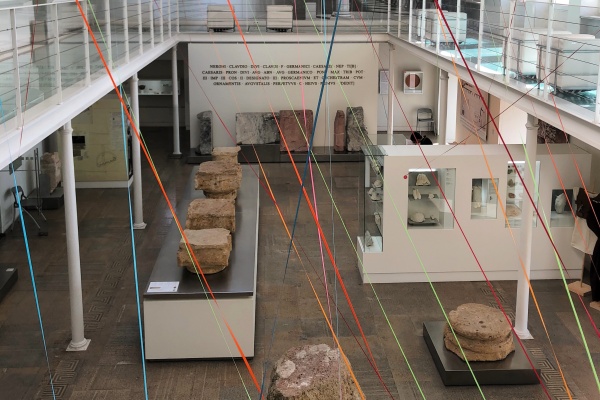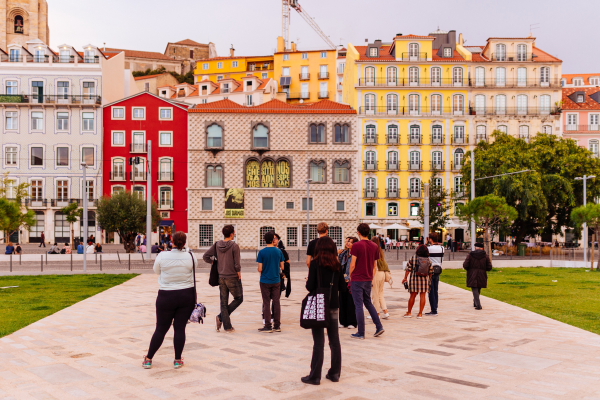Taking a look at Lisbon now, it’s hard to envision the city as part of the Ancient Roman Empire.
But there are plenty of traces of Roman influence scattered around the Portuguese capital. Some you’ll find in plain sight, while others you have to go a little deeper literally. There’s one, in particular, that’s so difficult to show that the City Council opted to open it to the public only once or twice a year.

Photo credit: Sandra Henriques Gajjar; Text overlay: Devour Lisbon Food Tours
The Roman Theater
Let’s start with the least surprising place to see Roman ruins in Lisbon: the Museu do Teatro Romano (Roman Theater Museum). Most people who choose to get to the S. Jorge Castle on foot, from one of Lisbon’s miradouros, and follow their smartphone’s map app will have come across the fenced open-air archeological excavation.
The set of half-ruined columns and stone seats may not look like much to the untrained eye, but they form one of the most important monuments of the city once known by its Roman name Olisipo. None of this makes sense until you visit the museum next door which explains all the city’s cultural layers and influences over time.
Insider’s tip: Entrance is free until 2.00 p.m. on Sundays, national holidays, International Museum Day, and Lisbon’s holiday (June 13th).

Roman Ruins Hidden Under a Bank
There’s a story that’s quite frequent in Lisbon: starting construction, digging a hole, and finding archeological remains without much effort. After the Great Earthquake of 1755, when most of Lisbon’s downtown was destroyed by a series of earthquakes, tsunamis, and fires, rebuilding the city was urgent. Therefore, most of the city’s cultural heritage was forever buried under new buildings’ foundations. Until, of course, the buildings needed renovations.
Fast forward 200 years from those days, until the early 1990s when the headquarters of the Millennium BCP bank needed renovation work. They didn’t just find Roman ruins. They found 2,500 years of History through structures left by civilizations that once called Lisbon home.
Aware of the importance of this finding, the bank decided to give free access to the ruins at what is now called Núcleo Arqueológico da Rua dos Correeiros.
Insider’s tip: There are free guided tours every day, except on Sundays and national holidays.

A Roman Fish Factory Under a Nobel Prize Winner’s Foundation
It’s not every day that you can visit a foundation dedicated to the 1998 Literature Nobel Prize winner, José Saramago, and Roman ruins all in one place. Well, actually, in Lisbon the old and the new come together under the same roof a lot.
The current Casa dos Bicos as we know it is an improvement to the original, and esthetically unusual, 16th-century building. The City Council granted the top two floors, added later, to Fundação José Saramago in 2008.
The first floor is reserved for the archeological remains found in the 1980s, including what is left of a 1st century AD Roman fish processing unit. Exporting processed fish products and oysters were one of the leading businesses of Romans in Lisbon at the time. Those factories were built by the river, which used to go up all the way to Casa dos Bicos.
Insider’s tip: If you find a Roman fish processing factory unexciting, they also display fragments of everyday pieces that precede the 1755 earthquake. Considering most of the city was destroyed then, those are rare findings.

Underground Roman Galleries
If you happen to be visiting Lisbon around International Museum Day (mid-May), you might find it odd to see people vanishing through a hole in the ground at Rua da Conceição in the Baixa neighborhood. Worry not, they’re just being led by the City Council’s team of archeologists and historians who volunteer every year to show Lisbon’s underground Roman galleries.
These Roman galleries from the 1st century AD were discovered by accident during the post-1755 Great Earthquake reconstruction. Most of the structure was blocked by the new sewage system built in the 18th century, except this small area you can visit today. Opening the galleries requires draining them before and during visiting days and rerouting all traffic.
Before when visits were free and people were allowed to line up for hours, the scenario looked far more dramatic with people led by curiosity joining in every few minutes. In good time the City Council decided to charge €1.00 per person and implement a scheduling system that allows them to be more organized. News of the opening travels fast once the Museu de Lisboa publishes the new dates on their official Facebook page. You have to be quick if you want to grab a spot.
Insider’s tip: wear comfortable waterproof shoes and mind your head.






